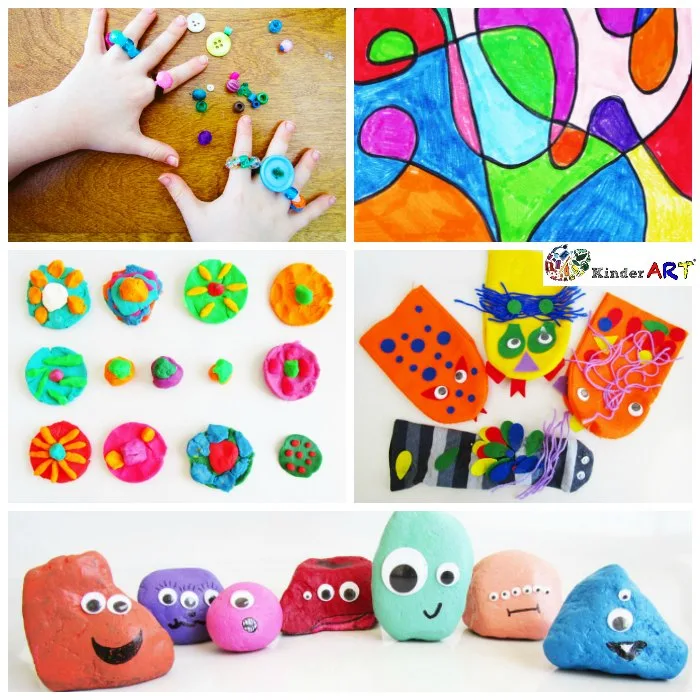 illustration from KinderArt
illustration from KinderArt
Unlocking Your Child's Potential: The Ultimate Guide to Creative Kids Activities
In today's world, fostering creativity in children is crucial. Creative activities offer fun, boost critical thinking, problem-solving, and emotional expression. This guide provides creative activities for all ages, with tips and benefits of incorporating creativity into your child's life.
Why Creativity Matters
Creativity isn't just about art; it's a key skill that helps kids solve problems, express themselves, and love learning. It boosts brainpower, emotional health, and social skills. Here's how:
- Cognitive Development: Creative activities boost memory, focus, and problem-solving. They train the brain to be adaptable.
- Emotional Well-being: Art and play help kids express emotions safely, manage stress, and build confidence.
- Social Skills: Creative projects teach teamwork, communication, and empathy. Kids learn to share ideas and support each other.
- Problem-Solving Skills: Kids learn to persevere and learn from mistakes. Building or mixing colors teaches resilience.
- Boost Confidence: Completing a project boosts self-esteem. Seeing ideas come to life is empowering.
Creative Activities for Different Age Groups
Tailor activities to your child's age. Here's a breakdown:
Toddlers (1-3 Years)
Toddlers are curious. Focus on activities that engage their senses and movement.
- Finger Painting: Let them explore colors with non-toxic paints. Use a large, washable surface.
- Playdough: Great for sensory exploration and motor skills. Provide tools like rolling pins.
- Water Play: Fill a bin with water and provide cups and toys. Supervise closely.
- Building Blocks: Encourage spatial reasoning. Use large, soft blocks.
- Music and Movement: Play music and encourage dancing. Use scarves and instruments.
Preschoolers (3-5 Years)
Preschoolers have longer attention spans. Encourage imagination and storytelling.
- Drawing and Coloring: Provide crayons and paper. Encourage them to draw or create stories.
- Craft Projects: Make collages or paper plate masks. Use recycled materials.
- Storytelling: Read stories and encourage your child to create their own endings. Use puppets.
- Dress-Up: Provide costumes and let them play pretend.
- Nature Walks: Collect leaves and twigs. Create nature collages.
School-Aged Children (6-12 Years)
They can handle complex projects requiring planning and detail.
- Painting: Introduce techniques like watercolor. Provide brushes and canvases.
- Sculpture: Use clay or recycled materials. Experiment with textures.
- Creative Writing: Encourage stories and poems. Provide prompts.
- Photography: Teach the basics and let them experiment.
- Building and Construction: Provide LEGOs and encourage building.
Teenagers (13+ Years)
They benefit from outlets for self-expression.
- Digital Art: Explore software like Photoshop.
- Music Production: Provide software and instruments.
- Filmmaking: Encourage writing and editing short films.
- Creative Writing: Participate in workshops.
- Graphic Design: Create logos and websites.
Creative Activity Ideas
Adapt these for different ages:
- DIY Cardboard Creations: Use boxes to create structures.
- Nature Art: Use leaves and stones.
- Homemade Instruments: Use recycled materials.
- Tie-Dye: Create colorful clothing.
- DIY Jewelry: Use beads.
- Rock Painting: Paint rocks and hide them.
- DIY Bath Bombs: Use essential oils.
- Homemade Slime: Experiment with recipes.
- DIY Candles: Use wax and essential oils.
- DIY Soap: Use natural ingredients.
Tips for Fostering Creativity
Create a supportive environment:
- Provide a Creative Space: Designate a space with art supplies.
- Offer Unstructured Time: Allow time for their own projects.
- Encourage Experimentation: Let them make mistakes.
- Provide Positive Feedback: Focus on the process.
- Be a Role Model: Show you value creativity.
- Visit Museums and Art Galleries: Expose them to art.
- Read Books and Watch Movies: Spark imagination.
- Limit Screen Time: Encourage other activities.
- Embrace Messes: Provide cleaning supplies.
- Celebrate Creativity: Display artwork and attend performances.
The Future of Creativity
Creativity will be valuable. It's essential for success in the future.
Conclusion
Creative activities offer many benefits and empower children. By providing opportunities and support, we can help them unlock their potential. Let their imagination soar!
Published on February 10, 2025
reference: Various Article on internet
Gema
Wordsmith and content writer passionate about creating high-quality content that informs, entertains, and inspires. Let me bring your brand's story to life.
All stories by : Gema

0 Comments